Cinnamon
Cinnamon is an ancient spice, and was used culinarily and medicinally in both ancient Egypt and China. This spice comes from the inner bark of the cinnamon tree, which rolls into a “cinnamon stick” shape when it is dried. These sticks are either used whole, or ground into powdered form.There are over 100 varieties of cinnamon, although what we commonly consume in the West is cassia cinnamon, which hails from China. Ceylon cinnamon is known as “true cinnamon,” and has a subtler flavor, but it is difficult to find in this part of the world.
 This sweet, aromatic spice is rich in minerals, including calcium and
manganese. It also contains a number of essential oils with active
components, including cinnamaldehyde, cinnamyl alcohol and cinnamyl
acetate.
This sweet, aromatic spice is rich in minerals, including calcium and
manganese. It also contains a number of essential oils with active
components, including cinnamaldehyde, cinnamyl alcohol and cinnamyl
acetate.These volatile compounds, as well as other antioxidants found in cinnamon bark, have potent anti-inflammatory properties and help to combat disease-promoting free radicals.
Thanks to its essential oil content, cinnamon possesses antibacterial, antiviral and antifungal properties. A 2013 study published in the International Journal of Food Microbiology found that when cinnamon was added to carrot broth, it effectively controlled the spread of Bacillus cereus, a foodborne bacteria, for sixty days.
The cinnamaldehyde in cinnamon has been found to improve circulation and prevent the unwanted clumping of blood platelets. Because of this, it may aid in the prevention of heart attack and stroke.
Cinnamon is linked to helping to lower blood sugar, as it can slow the emptying rate of the stomach after ingesting food. This improves insulin sensitivity, and can therefore be of great use to individuals suffering from diabetes, as well as those diagnosed with pre-diabetes.
The anti-inflammatory properties of cinnamon make it a key food in relieving multiple types of pain, including joint pain, headaches and menstrual cramping. Furthermore, cinnamon has been linked to boosting cognitive function – just a whiff of its aroma may help to improve focus and memory.
Honey
 Honey, like cinnamon, is also an ancient food celebrated for
thousands of years for both its amazing taste and potent medicinal
properties. Hippocrates, the father of modern medicine, refers to it as
“liquid gold” in his writings. However, not all honey is created equal.
Honey, like cinnamon, is also an ancient food celebrated for
thousands of years for both its amazing taste and potent medicinal
properties. Hippocrates, the father of modern medicine, refers to it as
“liquid gold” in his writings. However, not all honey is created equal.Processed, refined honey is a far cry from natural, raw honey. Many honeys that have undergone heavy processing no longer contain pollen, which is an important part of real honey’s health benefits. Also, some honey products that hail from India and other parts of Asia have been found to contain contaminants, and even antibiotics and metals.
While a certified organic honey is likely a safe bet, your absolute best source for honey is a local, raw variety.
Raw honey
The importance of finding a raw honey from a local source rests in its ability to help desensitize your body to allergens commonly found in the area where you live. When bees produce honey, they deposit a small amount of pollen into it. Eating a spoon or two of local, raw honey can help build up your immunity to environmental allergens in your hometown.Raw honey can also be extremely beneficial during a cold or cough. Adding a teaspoon of honey to your tea is not just an old wives tale: it has been scientifically studied to work. A 2007 study performed at the University of Pennsylvania gave either raw honey or Dextromethorphan (DM), a cough suppressant medication, to children between the ages of 2 and 17 who were suffering from upper respiratory infections.
Upon analyzing the results, the study authors wrote: "In a comparison of honey, DM, and no treatment, parents rated honey most favorably for symptomatic relief of their child’s nocturnal cough and sleep difficulty due to upper respiratory tract infection. Honey may be a preferable treatment for the cough and sleep difficulty associated with childhood upper respiratory tract infection."
Raw honey has antibacterial, antifungal and antiseptic properties, and can be applied topically to both disinfect and help heal numerous wounds and skin conditions, including minor burns, eczema and dermatitis. When it is ingested, these properties can help to support your immune system in dealing with pathogens that may make you sick if left unchecked.
One particularly potent type of honey is manuka honey. This honey, which hails from the flower nectar of the manuka tree, native to Australia and New Zealand, has been found to have up to 200 times the antibacterial potency of any other honey. Manuka honey can also help to support healthy gut bacteria, which along with improving digestion may provide a significant boost to your immune system.
Note: Honey should not be given to children under 12 months of age.
When their powers combine…
In both Ayurvedic medicine and traditional Chinese medicine, the combination of cinnamon and honey has been long celebrated. The following are just a few benefits of blending these two superfoods:
- Boosting the immune system to help prevent seasonal illnesses and other infections
- Speeding recovery from colds and other seasonal ailments
- Clearing sinus congestion
- Soothing indigestion and other digestive disturbances
- Aiding in recovery from bladder infections
- Supporting healthy weight loss when combined with a healthy diet and exercise
- Aiding in the prevention of heart disease and other chronic ailments
- Potentially increasing longevity
8 Acupressure Points That You Can Stimulate To Cure Everything From Headaches To Nausea!
When you bump your elbow or stub your toe, your first instinct is to touch the spot that hurts, isn’t it? This instinct, to soothe pain with touch, forms the basis of acupressure.A 5,000-year-old form of traditional Chinese healing, acupressure attempts to balance life energy (qi) by applying pressure to certain points along the body. These acupoints are located along channels of energy in the body, known as meridians. We usually experience pain when these meridians are blocked or out of balance.
Acupressure unblocks these meridians by applying pressure to these acupoints, which triggers the release of endorphins in the brain. Endorphins reduce pain and trigger feelings of pleasure. Once your body is no longer in pain, your muscles can relax and so your blood flow improves, allowing your body to come back into balance. Acupressure is a safe practice for beginners, and if you don’t get the exact point, you will still be okay. However, pregnant women and cancer patients shouldn’t attempt to do acupressure without supervision.
There are hundreds of acupoints on the human body, however, these are a few basic ones that you can start with.
1. Headaches: Joining the Valley (L 14)
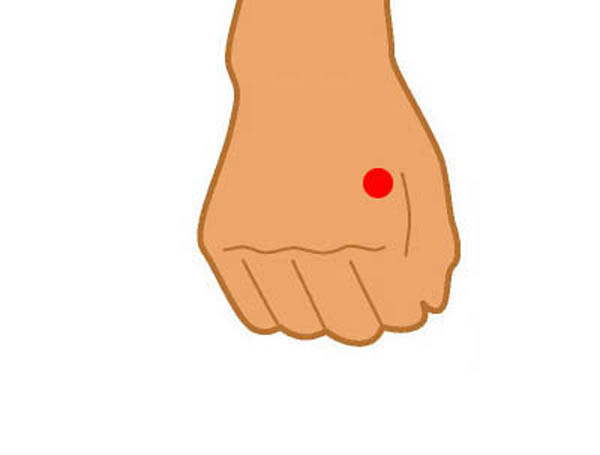
via Top10homeremedies
This point is commonly used to cure headaches, but it can also treat toothaches, neck pain, shoulder pain, arthritis, hangovers and constipation.
Location: Between the thumb and forefinger, at the highest point of the muscle, where the two fingers are joined.
How to press it: Press and massage the point on one hand for a few minutes, then do the same to the other hand. Repeat as required.
2. Nausea and vomiting: Pericardium (P6)
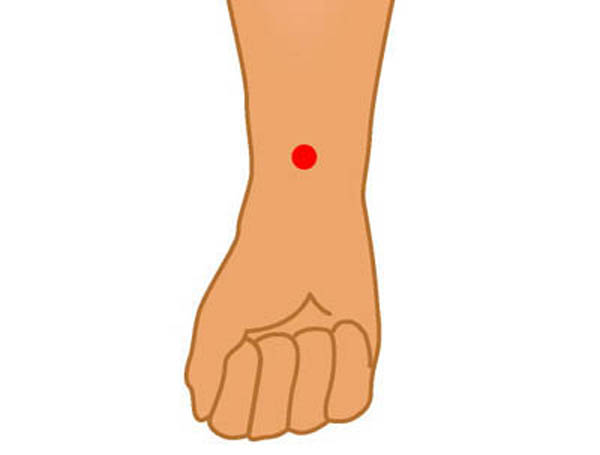
via Top10homeremedies
This point helps prevent nausea and vomiting that is caused by a number of factors, including pregnancy, motion-sickness and chemotherapy. It also helps treat upset stomachs, headaches, chest pain and carpel tunnel syndrome.
Location: This point is located between the two large tendons on the inside of your wrist, about 3 finger widths below the base of your palm.
How to press it: Press the point with your index and middle fingers for half a minute, then do the same on your other hand. Repeat several times, till the nausea passes.
3. Fatigue and eye strain: Third Eye (GV24.5)

via Top10homeremedies
This point relieves fatigue, eye strain, headaches, insomnia, sinus problems and congestion. It also improves memory, calms you down and improves your spiritual and emotional health.
Location: This point is located where the bridge of your nose meets the middle of your eyebrows.
How to press it: Use your middle finger to press this point for a few seconds, for up to a minute. Try to do this several times a week.
4. Depression: Sea of Tranquillity (CV 17)
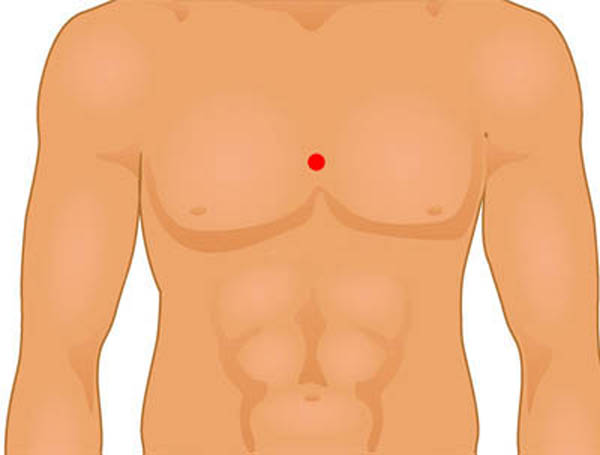
via Top10homeremedies
Also known as Conception Vessel 17 (CV 17), this point helps with emotional and mental health problems like depression, anxiety, nervousness and hysteria. It also helps improve immunity.
Location: This point is located in a dent in your breastbone, about 3 – 4 finger widths above the base of the breastbone. It is pretty much in the centre of your chest, between your nipples.
How to press it: Sit on a chair with your spine absolutely erect. Join your hands as though you are praying, with your fingers pointing upward. Press the knuckles of your thumb into this point, moving your hands up and down for a few minutes while taking deep breaths.
5. Digestive problems: Leg Three Miles (ST 36)
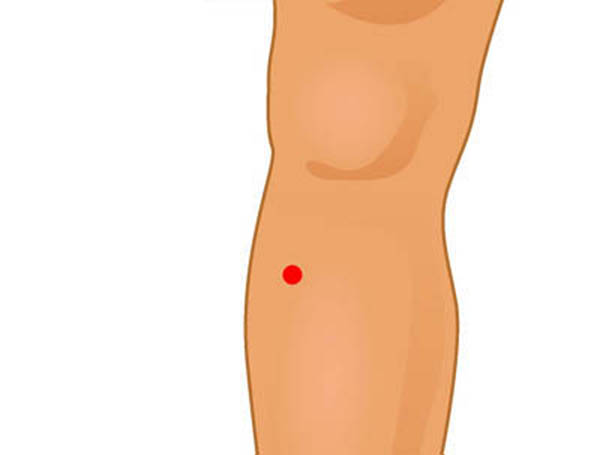
via Top10homeremedies
This point is used to relieve all sorts of digestive problems like gas, diarrhoea, constipation, nausea, vomiting, bloating and indigestion. It also boosts immunity, prevents fatigue and improves your overall wellness.
Location: Bend your leg and wrap your fingers around your leg, just below your kneecap. The point is located where your little finger rests, not in the middle of your leg, but on the outside of your shin bone. On your right leg, this point will be a little to the right of the centre of your leg and on your left leg this point will be a little to the left of the centre of your leg.
How to press it: Apply moderate pressure to this point for a few seconds every day. You can press the point on both legs at the same time.
6. Knee pain: Commanding Middle (B 54)
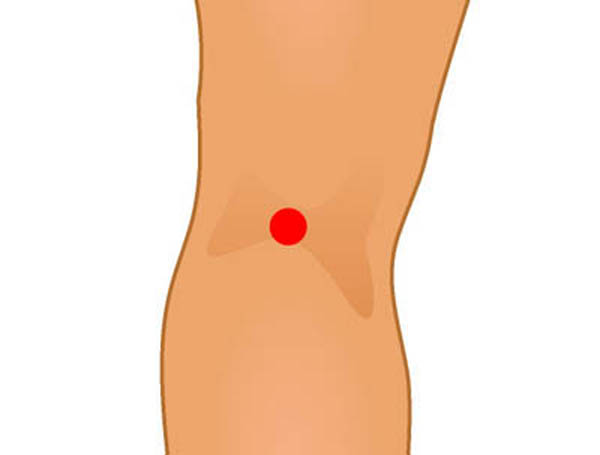
via Top10homeremedies
This point helps treat problems related to arthritis and sciatica, like knee pain, back pain, hip pain and stiffness.
Location: This point is located behind your knee, right in the centre of the kneecap area.
How to press it: Press it gently for about a minute, then switch to the other leg. Repeat every day.
7. Menstrual pain: Sacral Points
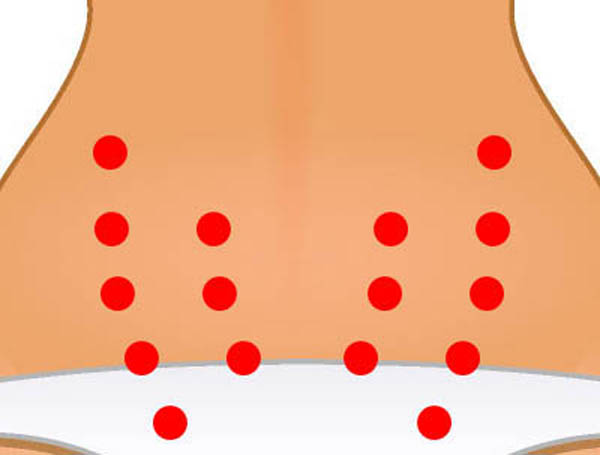
via Top10homeremedies
Pressing these points relaxes the uterus and relieves menstrual cramps. It also reduces lower back pain and sciatica pain.
Location: These points are located on the sacrum, which is at the base of the spine, right above the tailbone. When you press down on it, you should feel your sacrum bones, just below your upper buttocks.
How to press them: Lie down and place both hands on the area, one on top of the other, applying firm pressure on the area. Do this for a few minutes.
8. Insomnia and stress: Heavenly Pillar (B 10)
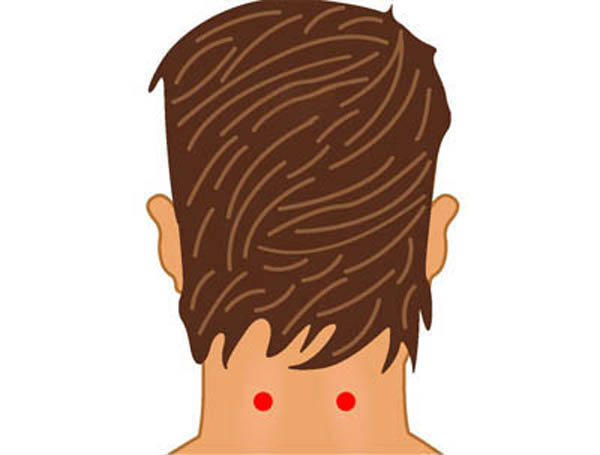
via Top10homeremedies
These points help with problems like stress, anxiety, exhaustion, burnout, headaches, heaviness in the head, neck pain and stiffness, insomnia and eye strain.
Location: These points are located 1 finger width below the base of the skull, on the neck muscles that jut out on either side of your spine.
How to press them: Press these points for a couple minutes every day, for several weeks.
Women: These Vegetable Proteins Can Protect Your Heart
A vegetarian or vegan lifestyle is not for everyone. Many people enjoy eating meat and in moderation, meat can be a healthy addition to your diet. This is especially true if you choose meat and fish from responsible sources, such as grass-fed, free-range and wild-caught products.Protein and heart failure research
To arrive at their results, researchers analyzed a large sample (just under 104,000) of women between the ages of 50 and 79. The amount of dietary protein, including meat protein and vegetable protein, that the women ate was assessed through self-reporting. Researchers collected data between 1993 and 1998. After results were adjusted for factors such as age, and risk factors for heart failure, researchers was found that:
“Higher total dietary protein intake (calibrated), appears to be associated with substantially increased heart failure risk while the vegetable protein intake appears to be protective against developing heart failure. Further studies are needed to explore this association.”
The potential trouble with too much meat
One reason for this association, according to Dr. Barbour, may be the way that animal protein works in the body at a molecular level. He explained that animal proteins are able to become toxic. This process may be detrimental to the left ventricle of the heart. On top of that, Dr. Barbour explains that eating a diet high in animal protein may be a factor in excess BMI, which can further contribute to heart failure.Can vegetable proteins really protect my heart?
While this study found that vegetable proteins seemed to offer a protective effect against heart failure, the quality of the diet and the health of lifestyle mattered even more. According to the study authors:“An inverse association was found between higher intakes of energy adjusted vegetable protein and HF [heart failure] although this association wasn’t statically significant if the association was adjusted to BMI and diet quality.”
A few great heart healthy options
Even those of us who enjoy eating meat could stand to eat it less often, as a plant-based diet is a key part of great health. The following are just a few options for delicious and nutritious complete vegetable proteins:- A combination of whole grains and legumes, such as brown rice and beans
- Chickpeas combined with nuts or seeds
- Spirulina with nuts
- Quinoa
- Chia seeds
- Hemp seeds
This is really an awesome resource that you are contributing to your readers for free. I always love to visit the blogs that provide quality info for free. I appreciate it Thank you, thank you so much! You can visit this blog below too if you wish:
ReplyDelete-
Cheers!